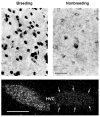Transsynaptic trophic effects of steroid hormones in an avian model of adult brain plasticity
- PMID: 25285401
- PMCID: PMC4385747
- DOI: 10.1016/j.yfrne.2014.09.003
Transsynaptic trophic effects of steroid hormones in an avian model of adult brain plasticity
Abstract
The avian song control system provides an excellent model for studying transsynaptic trophic effects of steroid sex hormones. Seasonal changes in systemic testosterone (T) and its metabolites regulate plasticity of this system. Steroids interact with the neurotrophin brain-derived neurotrophic factor (BDNF) to influence cellular processes of plasticity in nucleus HVC of adult birds, including the addition of newborn neurons. This interaction may also occur transsynpatically; T increases the synthesis of BDNF in HVC, and BDNF protein is then released by HVC neurons on to postsynaptic cells in nucleus RA where it has trophic effects on activity and morphology. Androgen action on RA neurons increases their activity and this has a retrograde trophic effect on the addition of new neurons to HVC. The functional linkage of sex steroids to BDNF may be of adaptive value in regulating the trophic effects of the neurotrophin and coordinating circuit function in reproductively relevant contexts.
Keywords: BDNF; Bird; Estrogen; Neurogenesis; Neurotrophin; Plasticity; Season; Songbird; Steroid; Testosterone.
Copyright © 2014 Elsevier Inc. All rights reserved.
Figures





Similar articles
-
Rapamycin blocks the neuroprotective effects of sex steroids in the adult birdsong system.Dev Neurobiol. 2019 Aug;79(8):794-804. doi: 10.1002/dneu.22719. Epub 2019 Sep 23. Dev Neurobiol. 2019. PMID: 31509642 Free PMC article.
-
Testosterone and brain-derived neurotrophic factor interactions in the avian song control system.Neuroscience. 2013 Jun 3;239:115-23. doi: 10.1016/j.neuroscience.2012.09.023. Epub 2012 Oct 30. Neuroscience. 2013. PMID: 23123886 Free PMC article. Review.
-
Brain-Derived Neurotrophic Factor Has a Transsynaptic Trophic Effect on Neural Activity in an Adult Forebrain Circuit.J Neurosci. 2020 Feb 5;40(6):1226-1231. doi: 10.1523/JNEUROSCI.2375-19.2019. Epub 2019 Dec 19. J Neurosci. 2020. PMID: 31857358 Free PMC article.
-
Plasticity of the adult avian song control system.Ann N Y Acad Sci. 2004 Jun;1016:560-85. doi: 10.1196/annals.1298.006. Ann N Y Acad Sci. 2004. PMID: 15313795 Review.
-
Steroid hormones act transsynaptically within the forebrain to regulate neuronal phenotype and song stereotypy.J Neurosci. 2007 Oct 31;27(44):12045-57. doi: 10.1523/JNEUROSCI.3289-07.2007. J Neurosci. 2007. PMID: 17978046 Free PMC article.
Cited by
-
Sodium Fluoride In Vitro Treatment Affects the Expression of Gonadotropin and Steroid Hormone Receptors in Chicken Embryonic Gonads.Animals (Basel). 2021 Mar 26;11(4):943. doi: 10.3390/ani11040943. Animals (Basel). 2021. PMID: 33810503 Free PMC article.
-
Rapamycin blocks the neuroprotective effects of sex steroids in the adult birdsong system.Dev Neurobiol. 2019 Aug;79(8):794-804. doi: 10.1002/dneu.22719. Epub 2019 Sep 23. Dev Neurobiol. 2019. PMID: 31509642 Free PMC article.
-
Otx2 mRNA expression is downregulated following traumatic brain injury in zebra finches.Front Neural Circuits. 2025 Jun 6;19:1591983. doi: 10.3389/fncir.2025.1591983. eCollection 2025. Front Neural Circuits. 2025. PMID: 40547083 Free PMC article.
-
[Hormonal influence on hearing].HNO. 2021 Dec;69(12):987-995. doi: 10.1007/s00106-021-01019-y. Epub 2021 Mar 16. HNO. 2021. PMID: 33725160 German.
-
Activity Dependency and Aging in the Regulation of Adult Neurogenesis.Cold Spring Harb Perspect Biol. 2015 Nov 2;7(11):a018929. doi: 10.1101/cshperspect.a018929. Cold Spring Harb Perspect Biol. 2015. PMID: 26525149 Free PMC article. Review.
References
-
- Tramontin AD, Brenowitz EA. Seasonal plasticity in the adult brain. Trends Neurosci. 2000;23:251–8. - PubMed
-
- Ball GF, Castelino CB, Maney DL, Appeltants D, Balthazart J. The activation of birdsong by testosterone: multiple sites of action and role of ascending catecholamine projections. Ann N Y Acad Sci. 2003;1007:211–31. - PubMed
-
- Catchpole CK, Slater PJB. Bird song: Biological themes and variations. Cambridge University Press; Cambridge, U.K: 2008.
-
- Beecher MD, Brenowitz EA. Functional aspects of song learning in the songbirds. Trends Ecol Evol. 2005;20:143–149. - PubMed
-
- Brenowitz EA, Beecher MD. Song learning in birds: diversity, plasticity, opportunities and challenges. Trends Neurosci. 2005;28:127–32. - PubMed
Publication types
MeSH terms
Substances
Grants and funding
LinkOut - more resources
Full Text Sources
Other Literature Sources

